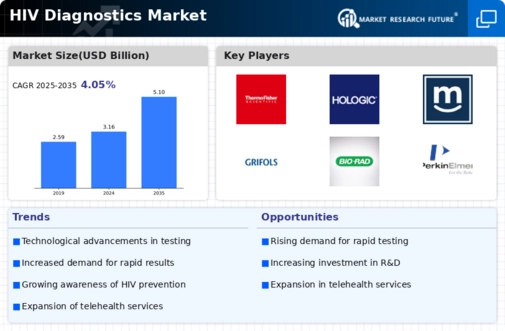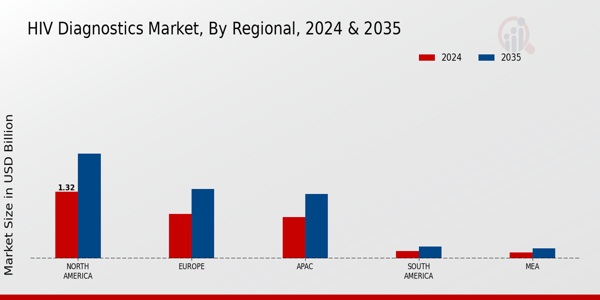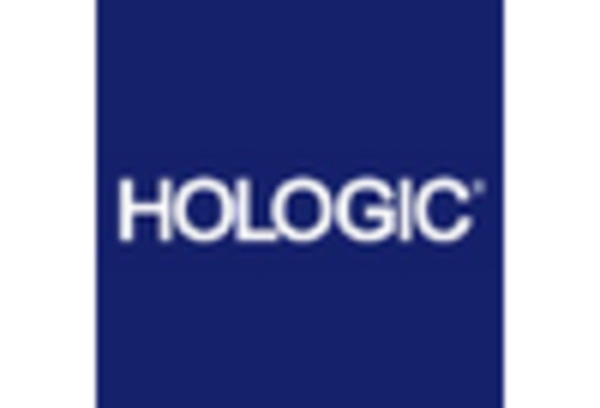Antibody Tests
Antigen Tests
Nucleic Acid Tests
Hospitals
Diagnostic Laboratories
Home Care Settings
Tests Kits
Instruments
Software
Elisa
Rapid Testing
Polymerase Chain Reaction
North America
Europe
South America
Asia Pacific
Middle East and Africa
North America Outlook (USD Billion, 2019-2035)
North America HIV Diagnostics Market by Test Type
Antibody Tests
Antigen Tests
Nucleic Acid Tests
North America HIV Diagnostics Market by End User Type
Hospitals
Diagnostic Laboratories
Home Care Settings
North America HIV Diagnostics Market by Product Type
Tests Kits
Instruments
Software
North America HIV Diagnostics Market by Technology Type
Elisa
Rapid Testing
Polymerase Chain Reaction
North America HIV Diagnostics Market by Regional Type
US
Canada
US Outlook (USD Billion, 2019-2035)
US HIV Diagnostics Market by Test Type
Antibody Tests
Antigen Tests
Nucleic Acid Tests
US HIV Diagnostics Market by End User Type
Hospitals
Diagnostic Laboratories
Home Care Settings
US HIV Diagnostics Market by Product Type
Tests Kits
Instruments
Software
US HIV Diagnostics Market by Technology Type
Elisa
Rapid Testing
Polymerase Chain Reaction
CANADA Outlook (USD Billion, 2019-2035)
CANADA HIV Diagnostics Market by Test Type
Antibody Tests
Antigen Tests
Nucleic Acid Tests
CANADA HIV Diagnostics Market by End User Type
Hospitals
Diagnostic Laboratories
Home Care Settings
CANADA HIV Diagnostics Market by Product Type
Tests Kits
Instruments
Software
CANADA HIV Diagnostics Market by Technology Type
Elisa
Rapid Testing
Polymerase Chain Reaction
Europe Outlook (USD Billion, 2019-2035)
Europe HIV Diagnostics Market by Test Type
Antibody Tests
Antigen Tests
Nucleic Acid Tests
Europe HIV Diagnostics Market by End User Type
Hospitals
Diagnostic Laboratories
Home Care Settings
Europe HIV Diagnostics Market by Product Type
Tests Kits
Instruments
Software
Europe HIV Diagnostics Market by Technology Type
Elisa
Rapid Testing
Polymerase Chain Reaction
Europe HIV Diagnostics Market by Regional Type
Germany
UK
France
Russia
Italy
Spain
Rest of Europe
GERMANY Outlook (USD Billion, 2019-2035)
GERMANY HIV Diagnostics Market by Test Type
Antibody Tests
Antigen Tests
Nucleic Acid Tests
GERMANY HIV Diagnostics Market by End User Type
Hospitals
Diagnostic Laboratories
Home Care Settings
GERMANY HIV Diagnostics Market by Product Type
Tests Kits
Instruments
Software
GERMANY HIV Diagnostics Market by Technology Type
Elisa
Rapid Testing
Polymerase Chain Reaction
UK Outlook (USD Billion, 2019-2035)
UK HIV Diagnostics Market by Test Type
Antibody Tests
Antigen Tests
Nucleic Acid Tests
UK HIV Diagnostics Market by End User Type
Hospitals
Diagnostic Laboratories
Home Care Settings
UK HIV Diagnostics Market by Product Type
Tests Kits
Instruments
Software
UK HIV Diagnostics Market by Technology Type
Elisa
Rapid Testing
Polymerase Chain Reaction
FRANCE Outlook (USD Billion, 2019-2035)
FRANCE HIV Diagnostics Market by Test Type
Antibody Tests
Antigen Tests
Nucleic Acid Tests
FRANCE HIV Diagnostics Market by End User Type
Hospitals
Diagnostic Laboratories
Home Care Settings
FRANCE HIV Diagnostics Market by Product Type
Tests Kits
Instruments
Software
FRANCE HIV Diagnostics Market by Technology Type
Elisa
Rapid Testing
Polymerase Chain Reaction
RUSSIA Outlook (USD Billion, 2019-2035)
RUSSIA HIV Diagnostics Market by Test Type
Antibody Tests
Antigen Tests
Nucleic Acid Tests
RUSSIA HIV Diagnostics Market by End User Type
Hospitals
Diagnostic Laboratories
Home Care Settings
RUSSIA HIV Diagnostics Market by Product Type
Tests Kits
Instruments
Software
RUSSIA HIV Diagnostics Market by Technology Type
Elisa
Rapid Testing
Polymerase Chain Reaction
ITALY Outlook (USD Billion, 2019-2035)
ITALY HIV Diagnostics Market by Test Type
Antibody Tests
Antigen Tests
Nucleic Acid Tests
ITALY HIV Diagnostics Market by End User Type
Hospitals
Diagnostic Laboratories
Home Care Settings
ITALY HIV Diagnostics Market by Product Type
Tests Kits
Instruments
Software
ITALY HIV Diagnostics Market by Technology Type
Elisa
Rapid Testing
Polymerase Chain Reaction
SPAIN Outlook (USD Billion, 2019-2035)
SPAIN HIV Diagnostics Market by Test Type
Antibody Tests
Antigen Tests
Nucleic Acid Tests
SPAIN HIV Diagnostics Market by End User Type
Hospitals
Diagnostic Laboratories
Home Care Settings
SPAIN HIV Diagnostics Market by Product Type
Tests Kits
Instruments
Software
SPAIN HIV Diagnostics Market by Technology Type
Elisa
Rapid Testing
Polymerase Chain Reaction
REST OF EUROPE Outlook (USD Billion, 2019-2035)
REST OF EUROPE HIV Diagnostics Market by Test Type
Antibody Tests
Antigen Tests
Nucleic Acid Tests
REST OF EUROPE HIV Diagnostics Market by End User Type
Hospitals
Diagnostic Laboratories
Home Care Settings
REST OF EUROPE HIV Diagnostics Market by Product Type
Tests Kits
Instruments
Software
REST OF EUROPE HIV Diagnostics Market by Technology Type
Elisa
Rapid Testing
Polymerase Chain Reaction
APAC Outlook (USD Billion, 2019-2035)
APAC HIV Diagnostics Market by Test Type
Antibody Tests
Antigen Tests
Nucleic Acid Tests
APAC HIV Diagnostics Market by End User Type
Hospitals
Diagnostic Laboratories
Home Care Settings
APAC HIV Diagnostics Market by Product Type
Tests Kits
Instruments
Software
APAC HIV Diagnostics Market by Technology Type
Elisa
Rapid Testing
Polymerase Chain Reaction
APAC HIV Diagnostics Market by Regional Type
China
India
Japan
South Korea
Malaysia
Thailand
Indonesia
Rest of APAC
CHINA Outlook (USD Billion, 2019-2035)
CHINA HIV Diagnostics Market by Test Type
Antibody Tests
Antigen Tests
Nucleic Acid Tests
CHINA HIV Diagnostics Market by End User Type
Hospitals
Diagnostic Laboratories
Home Care Settings
CHINA HIV Diagnostics Market by Product Type
Tests Kits
Instruments
Software
CHINA HIV Diagnostics Market by Technology Type
Elisa
Rapid Testing
Polymerase Chain Reaction
INDIA Outlook (USD Billion, 2019-2035)
INDIA HIV Diagnostics Market by Test Type
Antibody Tests
Antigen Tests
Nucleic Acid Tests
INDIA HIV Diagnostics Market by End User Type
Hospitals
Diagnostic Laboratories
Home Care Settings
INDIA HIV Diagnostics Market by Product Type
Tests Kits
Instruments
Software
INDIA HIV Diagnostics Market by Technology Type
Elisa
Rapid Testing
Polymerase Chain Reaction
JAPAN Outlook (USD Billion, 2019-2035)
JAPAN HIV Diagnostics Market by Test Type
Antibody Tests
Antigen Tests
Nucleic Acid Tests
JAPAN HIV Diagnostics Market by End User Type
Hospitals
Diagnostic Laboratories
Home Care Settings
JAPAN HIV Diagnostics Market by Product Type
Tests Kits
Instruments
Software
JAPAN HIV Diagnostics Market by Technology Type
Elisa
Rapid Testing
Polymerase Chain Reaction
SOUTH KOREA Outlook (USD Billion, 2019-2035)
SOUTH KOREA HIV Diagnostics Market by Test Type
Antibody Tests
Antigen Tests
Nucleic Acid Tests
SOUTH KOREA HIV Diagnostics Market by End User Type
Hospitals
Diagnostic Laboratories
Home Care Settings
SOUTH KOREA HIV Diagnostics Market by Product Type
Tests Kits
Instruments
Software
SOUTH KOREA HIV Diagnostics Market by Technology Type
Elisa
Rapid Testing
Polymerase Chain Reaction
MALAYSIA Outlook (USD Billion, 2019-2035)
MALAYSIA HIV Diagnostics Market by Test Type
Antibody Tests
Antigen Tests
Nucleic Acid Tests
MALAYSIA HIV Diagnostics Market by End User Type
Hospitals
Diagnostic Laboratories
Home Care Settings
MALAYSIA HIV Diagnostics Market by Product Type
Tests Kits
Instruments
Software
MALAYSIA HIV Diagnostics Market by Technology Type
Elisa
Rapid Testing
Polymerase Chain Reaction
THAILAND Outlook (USD Billion, 2019-2035)
THAILAND HIV Diagnostics Market by Test Type
Antibody Tests
Antigen Tests
Nucleic Acid Tests
THAILAND HIV Diagnostics Market by End User Type
Hospitals
Diagnostic Laboratories
Home Care Settings
THAILAND HIV Diagnostics Market by Product Type
Tests Kits
Instruments
Software
THAILAND HIV Diagnostics Market by Technology Type
Elisa
Rapid Testing
Polymerase Chain Reaction
INDONESIA Outlook (USD Billion, 2019-2035)
INDONESIA HIV Diagnostics Market by Test Type
Antibody Tests
Antigen Tests
Nucleic Acid Tests
INDONESIA HIV Diagnostics Market by End User Type
Hospitals
Diagnostic Laboratories
Home Care Settings
INDONESIA HIV Diagnostics Market by Product Type
Tests Kits
Instruments
Software
INDONESIA HIV Diagnostics Market by Technology Type
Elisa
Rapid Testing
Polymerase Chain Reaction
REST OF APAC Outlook (USD Billion, 2019-2035)
REST OF APAC HIV Diagnostics Market by Test Type
Antibody Tests
Antigen Tests
Nucleic Acid Tests
REST OF APAC HIV Diagnostics Market by End User Type
Hospitals
Diagnostic Laboratories
Home Care Settings
REST OF APAC HIV Diagnostics Market by Product Type
Tests Kits
Instruments
Software
REST OF APAC HIV Diagnostics Market by Technology Type
Elisa
Rapid Testing
Polymerase Chain Reaction
South America Outlook (USD Billion, 2019-2035)
South America HIV Diagnostics Market by Test Type
Antibody Tests
Antigen Tests
Nucleic Acid Tests
South America HIV Diagnostics Market by End User Type
Hospitals
Diagnostic Laboratories
Home Care Settings
South America HIV Diagnostics Market by Product Type
Tests Kits
Instruments
Software
South America HIV Diagnostics Market by Technology Type
Elisa
Rapid Testing
Polymerase Chain Reaction
South America HIV Diagnostics Market by Regional Type
Brazil
Mexico
Argentina
Rest of South America
BRAZIL Outlook (USD Billion, 2019-2035)
BRAZIL HIV Diagnostics Market by Test Type
Antibody Tests
Antigen Tests
Nucleic Acid Tests
BRAZIL HIV Diagnostics Market by End User Type
Hospitals
Diagnostic Laboratories
Home Care Settings
BRAZIL HIV Diagnostics Market by Product Type
Tests Kits
Instruments
Software
BRAZIL HIV Diagnostics Market by Technology Type
Elisa
Rapid Testing
Polymerase Chain Reaction
MEXICO Outlook (USD Billion, 2019-2035)
MEXICO HIV Diagnostics Market by Test Type
Antibody Tests
Antigen Tests
Nucleic Acid Tests
MEXICO HIV Diagnostics Market by End User Type
Hospitals
Diagnostic Laboratories
Home Care Settings
MEXICO HIV Diagnostics Market by Product Type
Tests Kits
Instruments
Software
MEXICO HIV Diagnostics Market by Technology Type
Elisa
Rapid Testing
Polymerase Chain Reaction
ARGENTINA Outlook (USD Billion, 2019-2035)
ARGENTINA HIV Diagnostics Market by Test Type
Antibody Tests
Antigen Tests
Nucleic Acid Tests
ARGENTINA HIV Diagnostics Market by End User Type
Hospitals
Diagnostic Laboratories
Home Care Settings
ARGENTINA HIV Diagnostics Market by Product Type
Tests Kits
Instruments
Software
ARGENTINA HIV Diagnostics Market by Technology Type
Elisa
Rapid Testing
Polymerase Chain Reaction
REST OF SOUTH AMERICA Outlook (USD Billion, 2019-2035)
REST OF SOUTH AMERICA HIV Diagnostics Market by Test Type
Antibody Tests
Antigen Tests
Nucleic Acid Tests
REST OF SOUTH AMERICA HIV Diagnostics Market by End User Type
Hospitals
Diagnostic Laboratories
Home Care Settings
REST OF SOUTH AMERICA HIV Diagnostics Market by Product Type
Tests Kits
Instruments
Software
REST OF SOUTH AMERICA HIV Diagnostics Market by Technology Type
Elisa
Rapid Testing
Polymerase Chain Reaction
MEA Outlook (USD Billion, 2019-2035)
MEA HIV Diagnostics Market by Test Type
Antibody Tests
Antigen Tests
Nucleic Acid Tests
MEA HIV Diagnostics Market by End User Type
Hospitals
Diagnostic Laboratories
Home Care Settings
MEA HIV Diagnostics Market by Product Type
Tests Kits
Instruments
Software
MEA HIV Diagnostics Market by Technology Type
Elisa
Rapid Testing
Polymerase Chain Reaction
MEA HIV Diagnostics Market by Regional Type
GCC Countries
South Africa
Rest of MEA
GCC COUNTRIES Outlook (USD Billion, 2019-2035)
GCC COUNTRIES HIV Diagnostics Market by Test Type
Antibody Tests
Antigen Tests
Nucleic Acid Tests
GCC COUNTRIES HIV Diagnostics Market by End User Type
Hospitals
Diagnostic Laboratories
Home Care Settings
GCC COUNTRIES HIV Diagnostics Market by Product Type
Tests Kits
Instruments
Software
GCC COUNTRIES HIV Diagnostics Market by Technology Type
Elisa
Rapid Testing
Polymerase Chain Reaction
SOUTH AFRICA Outlook (USD Billion, 2019-2035)
SOUTH AFRICA HIV Diagnostics Market by Test Type
Antibody Tests
Antigen Tests
Nucleic Acid Tests
SOUTH AFRICA HIV Diagnostics Market by End User Type
Hospitals
Diagnostic Laboratories
Home Care Settings
SOUTH AFRICA HIV Diagnostics Market by Product Type
Tests Kits
Instruments
Software
SOUTH AFRICA HIV Diagnostics Market by Technology Type
Elisa
Rapid Testing
Polymerase Chain Reaction
REST OF MEA Outlook (USD Billion, 2019-2035)
REST OF MEA HIV Diagnostics Market by Test Type
Antibody Tests
Antigen Tests
Nucleic Acid Tests
REST OF MEA HIV Diagnostics Market by End User Type
Hospitals
Diagnostic Laboratories
Home Care Settings
REST OF MEA HIV Diagnostics Market by Product Type
Tests Kits
Instruments
Software
REST OF MEA HIV Diagnostics Market by Technology Type
Elisa
Rapid Testing
Polymerase Chain Reaction










Leave a Comment